Introduction
In completing assignment 2, I, along with four other members of the group, was required to come up with an aluminum alloy that had the following composition: 0.4Mn, 0.08Cr, 4.0Mg, 0.11Si, and 0.25Fe. In addition, the aluminum alloy produced also needed to have a minimum total elongation of no less than 20%, while the minimum yield strength was expected to be 310Mpa. Our guide supervisor for the assignment was Dr. Zohreh Keshavarz. The main role of the guide supervisor was to ensure that we followed all the key processing steps of the alloy to achieve the aforementioned requirements.
Before the start of the process, our team convened a group meeting whereby we planned and discussed our course of action. Group members recommended that we meet once every week during which time the various group members would be assigned tasks, in addition to getting an update on the progressive report. Group members also suggested that in case the workload was too much, an extra team meeting be organized. This way, we were able to distribute the workload throughout the trimester and finish the work in good time. All the team members worked hard to complete the tasks assigned to them.
Literature Review
The 5083 aluminum alloy is characterized by high strength to weight ratio. In addition, it is reasonably super-elastic and resistant to corrosion (Hecht & Kannan 1995; Kaibyshev et al. 2003). For these reasons, the 5083 aluminium alloy has found wide application in diverse sectors of the economy such as the construction industries, marine industry, and the automotive industry, among others (Black, Kohser & Degarmo 2012). Nonetheless, the alloy needs additional strength for it to be used as a structural material (Sheppard & Raghunathan 1989). The addition of magnesium helps to increase strength to the Al-Mg alloys. Over the last few decades, Al-Mg alloys have found increased use in such industrial applications as in the manufacture of computers, consumer electronic products, communication equipments, and automobiles. As a substitutional solid solution, the Al-Mg alloy has a coarse grain structure typical of class 1 super-plasticity (Carroll et al. 1999; Doherty et al. 1997).
Among the alloys in the Al-Mg system, the 5083 alloy is the most common super-plastic alloy due to its good corrosion resistance, moderate strength, as well as high super-plastic formability (Lin et al. 2010; Park et al. 2003). Still, researchers continue to search for other newer Al-Mg alloys with low flow stress, low operating temperature, high elongation, high strain rate and excellent super-plasticity that can be mass produced. According to various studies on super-plastic Al alloys, one of the key requirements for the attainment of a viable super-plasticity is grain structure (Raghunathan 1989).
Extrusion
In extrusion, a work piece whose cross section areas and length are known is force through a die with a smaller cross sectional area than the work piece itself (Radetic et al. 2011). This leads to the formation of a metal with a new cross section area. However, the process affects some of the mechanical properties of a metal like ductility and yield strength. In their experiment on testing the flow stress as a function of strain rate in super plastic elongation, Shin et al. (2004) observed that a rise in strain rate resulted in decreased elongation at 300 °C. The researchers also observed an increase in the strain rate from 5×10−4 to 10−2 s−1. Such a poor super-plastic elongation as reported by the researchers is not unusual, as the grain size of the metal was not sub-micron (Shin et al. 2004). Separately, Jin (2004) noted that during extrusion, the 5083 aluminium alloy is achieved by decreasing the grain size distribution and increasing the average grain size in proportion to the average.
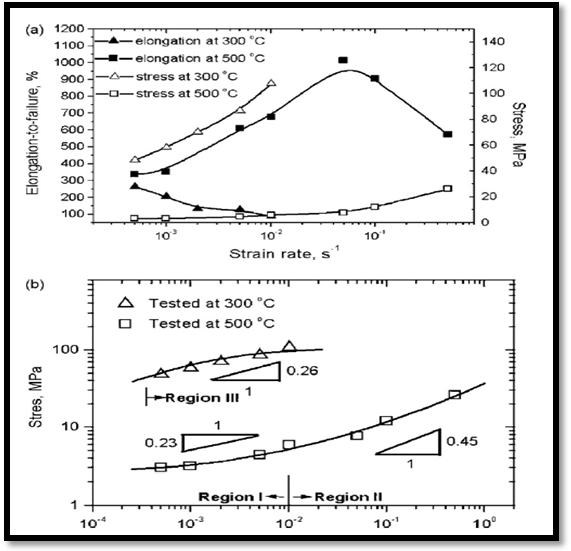
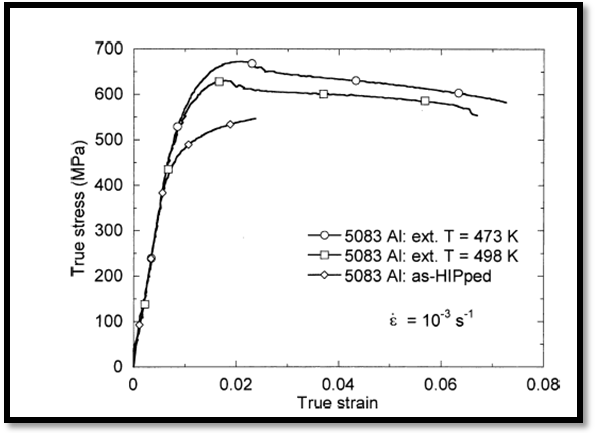
Hot rolling
Hot rolling allows for successive repetition of large deformation, even as the metal retains its ductile and soft properties. After the hot rolling process has began, it becomes hard to control the hardness of the material as it now depends on the rate of cooling following rolling, as well as its chemical composition. Ductility largely depends on the rolling direction of the metal. Tang, Hagiwara and Schoenung (2005) discovered that both the inner and outer particle regions of the metal were elongated in the direction of rolling following a period of hot rolling, as depicted in Fig 2 below:
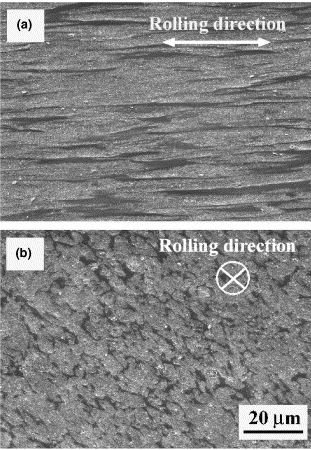
Cold Rolling
Cold rolling is a crucial process in the production of aluminium sheet and plate products, along with its alloys. In the manufacturing of aluminium alloys using cold rolling, one of the most commonly observed phenomena is edge cracking (as depicted in Fig. 1). As a result, the edges of the cracked material requires trimming, and this constitutes a significant loss in productivity. Only about half (50%) of the original material make it to the final product form, in a typical aluminium rolling plant. The reminder of the material gets lost through the various stages of the manufacturing process, and eventually finds its way back to the melting pot (Kannan, Vetrano & Hamilton 1996). Much of the loss in the production of aluminium alloy is due to edge trimming.
Another complex phenomenon that characterises the cold rolling process of metals and their alloys is ductile failure. This phenomenon is determined on such macroscopic factors as rolling speed, roll geometry, pass schedule or reduction ratio, friction or lubrication, temper and alloy (Valiev, Islamgaliev & Alexandrov 2000). Other factors to consider include microscopic factors like surface micro-topography, micro-structure, as well as mechanical properties. During cold rolling, atoms of the material are compressed against each other, resulting in improved yield strength of the original material (Robson 2002).
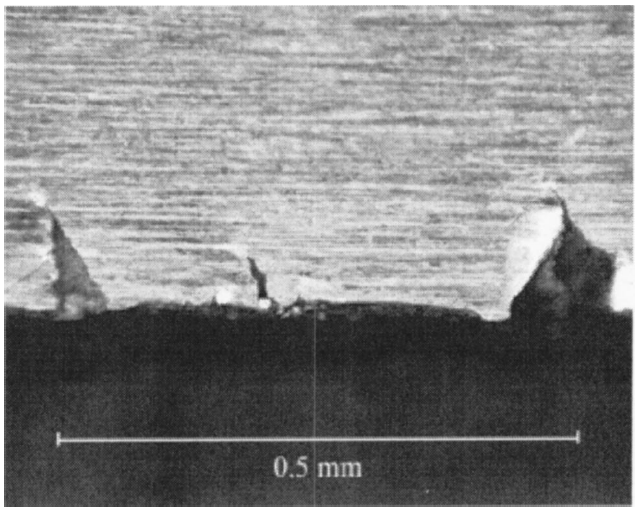
Annealing
The mechanical properties of a metal and its alloys are affected more by the annealing temperature, in comparison with the annealing holding time. There is need to optimize the annealing temperature the mechanical properties of a metal and its alloys. Annealing follows the cold and hot-rolling procedures to increases the stability (Gholinia, Humphreys & Prangnell 2002). Heat-treatment changes the micro-structure of the metal and its alloys, and his effectively modifies its mechanical properties. The presence of Al3Er precipitate in 5083 Al alloy, along with the Er added to it, enables the alloys to bear their deformed micro-structure. This is the case even when the annealing temperatures are very high. In our case, we lacked the Al3Er precipitate in our Al 5083. Even though deformation restorations help to recover the deformed micro-structure, nevertheless, getting a fully recrystallised micro-structure is difficult (Lin et al. 2010). The stable deformed substructure can be combined with the Al3Er precipitation, effectively yielding various micro-structures. The ensuing experimental alloy also possesses unusual corrosion and mechanical properties following the annealing process.
Results
We carried out a tensile test on our materials to determine its elongation and yield strength. Our sample material was 3mm in thickness, 25mm in length, and had a width of 5mm. To perform the test, a strain rate of 6mm/m was employed. Below are the results yielded by the tensile test:
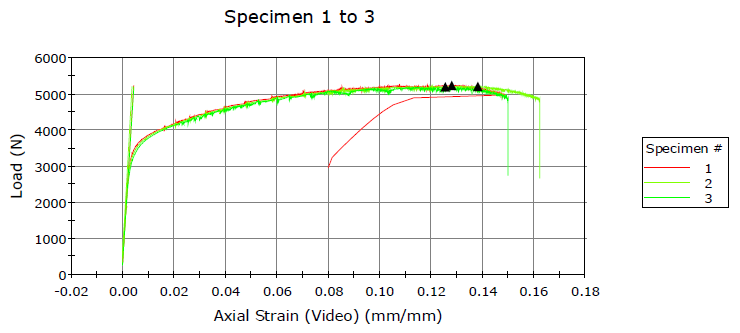

Based on the above results, the elongation was = 15.5%s-1
Yield strength =

The calculation above enabled us to determine the yield strength of the sample. However, we desired to have an elongation increment of 4.5% on the sample. Therefore, group members opted to subject the sample to both cold and hot rolling, followed by the annealing process. Below are the results for the three tests:
Hot Rolling: 1375N
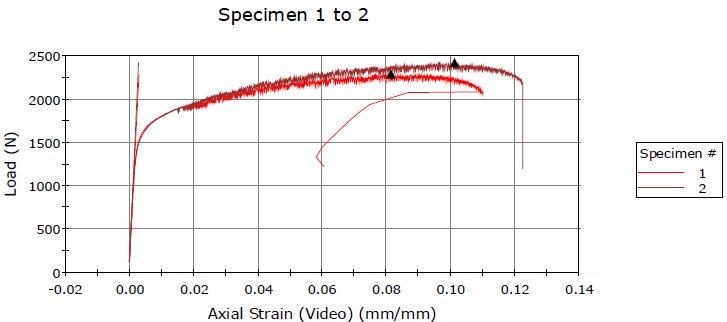
Table 2: Hot Rolling process
Hot Rolling + Annealing: 950N
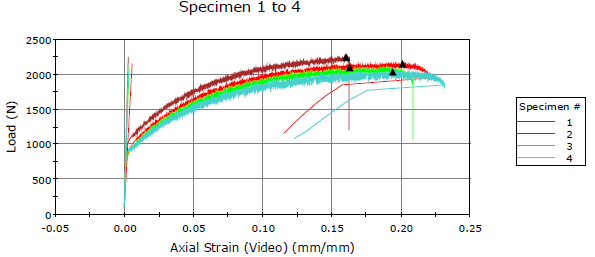
Ignoring the light blue specimen
Table 3: Hot Rolling Process and Annealing
Cold Rolling: 2250N
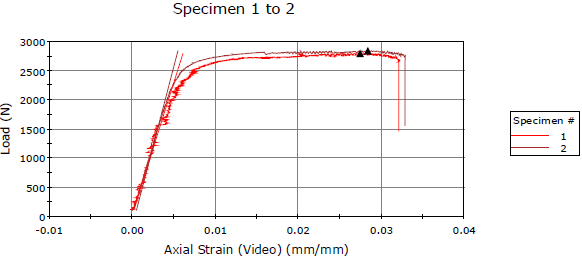
Table 4: Cold Rolling Process
Cold Rolling +Annealing: 950N

Table 5: Cold Rolling Process and Annealing
Discussion
By subjecting our sample to the cold rolling process, our intention was to enhance its yield strength via strain hardening. This is a process through which a metal is strengthened via plastic deformation. Work hardening causes dislocations on the crystalline grains of a metal. During plastic deformation, the disentangling between dislocations makes them harder to form and move, resulting in a more brittle, harder, and less ductile material (Gourdet & Montheillet 2000). For this reason, our group members decided to conduct this technique on our alloy since strain hardening is the only way to strengthen aluminium. Moreover, the technique is also a perfect way of hardening the material, thereby enhancing its yield strength as well.
Group members also deemed it necessary to hot roll part of the material in a bid to examine what could happen. This was also aimed at enabling group members to compare cold rolling with hot rolling. Hot rolling involves shaping the material to the desired shape and at the same time, reduces the effects of strain hardening on such a material. Due to the temperatures involved, there is no need to conduct strain hardening. Prior to placing the sample through the rolling machine, it is first heated to temperatures above its re-crystallisation temperature. The rolling process triggers the process of grains recrystalisation (Lee & Wu 1987). This is a necessary step as it protects the material against strain hardening as the grains will not have crystallised prior to the deformation of the material. Consequently, the material’s ductility remains comparatively high, even as its yield strength remains comparatively low.
Since our desire was to increase the level of these quantities in our material, as such, hot rolling was not our best choice because hypothetically, these values should actually remain constant. We were well aware that the ductility of our sample would reduce once we had subjected it to cold rolling, for this reason, group members deemed it necessary to anneal the material first, following a rolling down step to 1.5 mm by six passes. Each of the six passes had a thickness of 0.25 mm. This was aimed at restoring part of the lost ductility. In the annealing process, a worked sample is normally subjected to temperatures far beyond its critical temperature, and then holding it at that temperature for a given duration of time. Thereafter, the material is subjected to a cooling process. Recrystalisation of the grains that make up the metal occurs during the heating process, thereby relieving stress and undoing dislocations. Consequently, the softness and ductility of the sample increases as the dislocations have been undone.
On the other hand, prolonged heating of a metal or subjected is too to high temperatures will result in softening beyond the desired level (Yamashita, Horita & Langdon 2001). This was the case with our material. In our case, we annealed the material for 53 minutes at 500◦C, conditions that we came to learn were too long a time and too hot a temperature. I hypothesise that the grains had too much time to recrystallise, leading to bigger grains. This was the case with our sample. This resulted in yield strength of between 120 and 130 Mpa, for the cold and hot rolling. This is evidently below the original value.
What we should have done
We should never have subjected our sample to the hot rolling process as it turned out to be a waste of time. If we were granted a chance to redone this project, my recommendation to the group would be that we begin by cold rolling the material first in a bid to strain harden it. This is what our research findings have revealed. Nonetheless, there is need to conduct further research so that we can arrive at better informed decisions as regards the amount of material that needs reducing at each pass, as well as the number of rolls to perform beforehand. This could go a long way in increasing the yield strength of the material to the specified 320MPa following the cold rolling process. Once cold rolling has been done, I would then subject the material to the annealing process in an attempt to soften it slightly and also introduce ductility to it. Again, there is need to undertake further research on the annealing temperature and time in order to further reduce the yield strength of the material and possibly increase its elongation too.
Conclusion
The aforementioned assignment was a group work that consisted of four members, under the guidance of Dr. Zohreh Keshararz as our guide supervisor. We conducted a tensile strength on our sample material and the resulting yield strength was 313.72 Mpa. On the other hand, we realised an elongation increment of 4.5% on the material. We subjected the material to the cold rolling process with a view to increasing its yield strength. We also conducted a hot rolling process on part of the material for purposes of comparison with cold rolling. However, we must have subjected the material to too much heat for a long time as it had softened beyond its desired level. The experiment has taught us that we should never have hot rolled our material. Instead, we should have cold rolled it first, followed by annealing.
Reference List
Black, J, Kohser, R & Degarmo, E 2012, DeGarmo’s materials and processes in manufacturing, John Wiley & Sons, Hoboken, NJ.
Carroll, MC, Gouma, OI, Mills, MJ, Daehn, GS & Dunbar, BR 1999,’ Scripta’, Mater., Vol. 42, pp. 335-340.
Doherty, RD, Hughes, DA, Humphreys, FJ, Jonas, JJ, Jensen, DJ, Kassner, ME, King, WE, McNelley, TR, McQueen, JJ & Rollett, AD 1997,’ Mater’, Sci. Eng., Vol. 238A, pp. 219-274.
Ghosh, S, Li, M & Gardiner, D 2004,’A Computational and Experimental Study of Cold Rolling of Aluminum Alloys With Edge Cracking’, Journal of Manufacturing Science & Engineering, Vol. 126, pp. 74-82.
Gourdet, S & Montheillet, F 2000,’ Mater.’, Sci. Eng., Vol. A283, pp. 274-288.
Gholinia, A, Humphreys, FJ & Prangnell, PB 2002,’ Acta’, Mater., Vol. 50, pp. 4461-4476.
Hecht,RL & Kannan, K. 1995, in: A.K. Gosh, T.R. Bieler (Eds.), Superplasticity and Superplastic Forming, TMS, Warrendale, PA, USA.
Kannan, K, Vetrano, JS & Hamilton, CH 1996,’ Metall’, Mater. Trans., Vol. 27A, pp. 2947-2957.
Jin, M, Stach, AMM & Morris, JW 2004 ,’Direct observation of deformation-induced grain growth during the nanoindentation of ultrafine-grained Al at room temperature’, Acta Materialia, Vol. 52, No. 18, pp. 5381-5387.
Kaibyshev RMF, Lesuer, DR & Nieh TG 2003,’ Superplastic behavior of an Al–Mg alloy at elevated temperatures’, Mater Sci Eng., pp. 342:169.
Lee, SL & Wu, ST 1987,’Metall’, Trans., Vol. 18A, pp. 1353-1357.
Lin, S, Nie, Z, Huang, H & Li, B 2010,’ Annealing behavior of a modified 5083 aluminum alloy’, Materials & Design, Vol. 31, No. 3, pp. 1607–1612.
Park, KT, Hwang, DY, Lee, YK, Kim, YK & Shin, DH 2003,’High strain rate superplasticity of submicrometer grained 5083 Al alloy containing scandium fabricated by severe plastic deformation’, Materials Science and Engineering , Vol. A341, pp. 273 Á/281
Radetic, T, Popovic, M, Romhanjil, E, Milovic, B & Dodok, R 2011,’ Microstructure evolution of the hot-rolled modified AA 5083 alloys during the two stage thermal treatment’, Metalurgija-MjoM, Vol. 17, No. 1, pp. 41-47.
Raghunathan, TS 1989,’Mater’, Sci. Tech., Vol. 5, pp. 268-280.
Robson, JD 2002,’Mater’, Sci. Eng., pp.219-229.
Sheppard, T & Raghunathan, N 1989,’Mater’, Sci. Tech., Vol. 5, pp. 268-280.
Shin, DH, Oh, YJ & Park, KT 2004,’ Metall Mater’, Trans., pp. 825–837.
Tang, F, Hagiwara, M & Schoenung, JM 2005,’Formation of coarse-grained inter-particle regions during hot isostatic pressing of nanocrystalline powder’, Scripta Materialia, Vol. 53, No. 6,pp. 619–624.
Valiev, RZ, Islamgaliev, RK & Alexandrov, IV 2000,’Prog.’, Mater. Sci., Vol. 45, p. 103.
Witkin, D, Han, BQ & Laverna, EJ 2005,’Microstructural Evolution of an Ultrafine-grained Cryomilled Al 5083 Alloy During Thermomechanical Processing’, Journal of Materials Research, Vol. 20, No. 8, pp. 2117-2126.
Yamashita, A, Horita, Z & Langdon, TG 2001,’ Mater’, Sci. Eng., Vol. A300, p. 142.